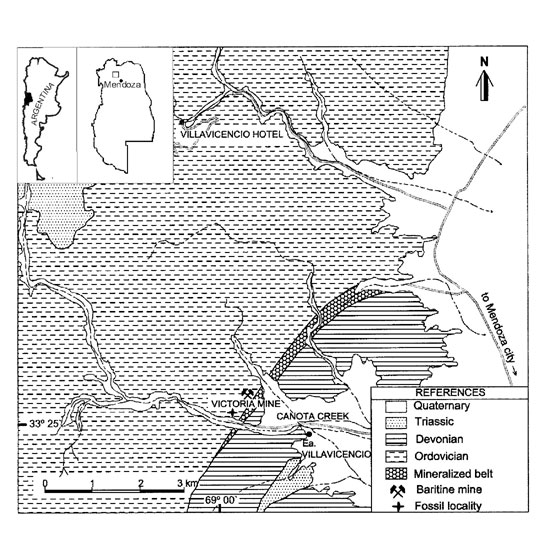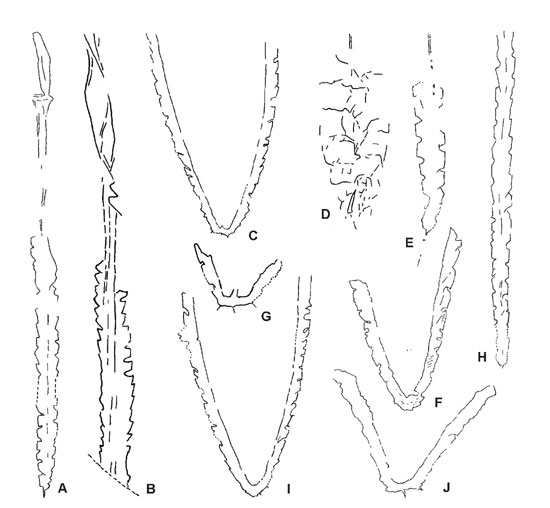
Biostratigraphic remarks on the Late Ordovician graptolite fauna from the area around Estancia Canota, Precordillera of Mendoza, Argentina
Edsel D. Brussa1, Blanca A. Toro2, Charles E. Mitchell3 and Ricardo A. ASTINI4
1 CONICET. Cátedra de Paleontología I, Facultad de Ciencias Exactas y Naturales, Universidad Nacional de La Pampa, Uruguay 151, (6300) Santa Rosa, La Pampa, Argentina. E–mail: ebrussa@exactas.unlpam.edu.ar
2 CONICET. Departamento de Geología y Paleontología del IANIGLA–CRICyT. Av. Ruíz Leal s/n, Parque General San Martín, (5500) Mendoza, Argentina. E–mail: btorogr@lab.cricyt.edu.ar
3 Department of Geology, State University of New York at Buffalo, Buffalo, NY 14260, USA. E–mail: cem@acsu.buffalo.edu
4 CONICET. Cátedra de Estratigrafía y Geología Histórica, Facultad de Ciencias Exactas, Físicas y Naturales, Universidad Nacional de Córdoba, Vélez Sarsfield 299, (5000) Córdoba, Argentina. E–mail: rastini@satlink.com
Key words: Graptolites. Late Ordovician. Precordillera. Mendoza. Argentina.
Introduction
Exposures with graptolites in the Precordillera of Mendoza are concentrated in the southern area (San Isidro and Canota), and in the San Rafael Block (Cerro Bola). This paper is mainly concerned with the analysis of new findings by the authors in the Estancia Canota region, which permit a closer correlation of the bearing beds with the outcrops in the San Isidro area (San Isidro, Los Bueyes and Agua de la Cruz). These faunas are currently under revision taking into account the allochthonous bodies and re–sedimented materials contained in these units.
The locality of Estancia Canota is 40 kilometers to the northwest of the city of Mendoza (Figure 1). Although graptolites were found there long ago, biostratigraphic interpretations have been controversial. The specimens described by Alfaro and Fernández (1985) were referred to the Caradoc (sensu lato), while Lavandaio (1986) proposed an uncertain Ordovician to Lower Silurian age for one of his assemblages, restricting the other one to the Lower Caradoc. Later, Cuerda and Alfaro (1993) mentioned nine new taxa for the Upper Shaly Member of the Villavicencio Formation in the Canota area, referring them to the Orthograptus truncatus intermedius – Orthograptus quadrimucronatus quadrimucronatus zones, which would be equivalent to the Upper Caradoc. There have also been diverse interpretations of the stratigraphical frameworks. Alfaro and Fernández (1985) distinguished the gray and black shale beds with graptolites from the sequences of rythmites that they assigned to the Villavicencio Formation, while Lavandaio (1986) included these in the "Villavicencio Group". Later, Cuerda et al. (1988) proposed a new stratigraphical framework, including the Villavicencio Formation (4800 meters thick) and the Canota Formation (900 meters thick). They proposed an Ordovician age for the former based on the graptolite content. The latter was referred to the Lower Devonian, correlating it with the plant–bearing beds of the San Isidro area (Cuerda et al., 1987). Lastly, Cuerda and Alfaro (1993) proposed different thicknesses for the Villavicencio Formation (2000 and 3000 meters, respectively), postulating an uncertain age ranging between the Lower Arenig and Llanvirn for the Psamo–Pelitic Lower Member and Upper Caradoc for the Upper Shaly Member. Both papers support the correlation of the graptolite–bearing beds with the Empozada Formation, exposed further south in the San Isidro area.
The San Isidro area is a classic locality with Ordovician exposures in the southern Precordillera and is located approximately 20 kilometers west of the city of Mendoza. The Empozada Formation includes siltstones (sometimes silicified) with Middle to Late Ordovician graptolites, and Cambrian to Early Ordovician graded sandstones, debris flow and allochthonus carbonatic blocks, all deposited in a deep slope environment (Bordonaro, 1985; Bordonaro and Peralta, 1987; Bordonaro et al., 1993; Heredia and Gallardo, 1996). Brussa and Toro (2000) recently mentioned an Upper Arenig graptolite fauna from one of these allochthonous blocks. Ortega and Albanesi (1998) analyzed graptolite fauna from the Climacograptus bicornis Zone in the Quebrada de Empozada, coming from beds overlying those previously assigned by Heredia and Gallardo (1996) to the Nemagraptus gracilis and Climacograptus bicornis zones. Mitchell et al. (1998) recognized the Dicellograptus complanatus and D. ornatus zones within the chert–rich black shale, just below the upper member of the Empozada Formation, exposed in the San Isidro creek. This finding was the first Ashgillian record for the Empozada Formation.

Figure 1. Location map (modified from Cuerda et al., 1988).
A systematic revision is currently under way including holotypes and paratypes of the species in the graptolite collection from the Empozada Formation in the San Isidro area (San Isidro and Los Bueyes). This material was collected by Rusconi who undertook fieldwork in the area during the 1940’s and 1950’s. The material is housed in the Museo de Ciencias Naturales y Antropológicas Juan Cornelio Moyano, in the city of Mendoza. Twenty two of the forty new taxa introduced by Rusconi between 1948 and 1956 have been revised already. Within the samples he described, additional material previously overlooked has been studied and will be published elsewhere (Toro and Brussa, 2001; Brussa and Toro, in prep.). At the same time, the authors have assembled their own graptolite collection from the Empozada Formation in the San Isidro area (San Isidro and Empozada creeks) and in the Villavicencio Formation in the Estancia Canota area in order to obtain accurate biostratigraphical and paleobiogeographic data for these lithostratigraphic unit.
Faunal composition and age
The analyzed assemblage in the Victoria Mine in the Estancia Canota area is dominated by biserial graptolites mainly represented by Climacograptus tubuliferus Lapworth, Normalograptus sp. cf. N. miserabilis (Elles and Wood) and remains of indeterminate normalograptids (Figure 2). Dicellograptids are less common although different forms can be determined, e.g., Dicellograptus sp. cf. D. complanatus Lapworth, Dicellograptus sp. cf. D. morrisi Hopkinson, Dicellograptus sp. cf. D. minor Toghill and Dicellograptus sp. cf. D. laticeps Storch. Less abundant yet are the remains of archiretiolits, among which Plegmatograptus can be distinguished.

Figure 2. Graptolites from the Canota area. A–B, Climacograptus tubuliferus Lapworth, IANIGLA–PI 1090 (x4,3), IANIGLA–PI 1091 (x2,9), respectively; C, Dicellograptus sp. cf. D. complanatus Lapworth, IANIGLA–PI 1092 (x3,4); D, Plegmatograptus sp., IANIGLA–PI 1093 (x7,6); E. Normalograptus sp., IANIGLA–PI 1094 (5,1x); F, Dicellograptus sp. cf. D. laticeps Storch, IANIGLA–PI 1095 (x5,7); G, Dicellograptus sp. cf. D. minor Toghill, IANIGLA–PI 1096 (x8); H, Normalograptus sp. cf. N. miserabilis (Elles and Wood), IANIGLA–PI 1097 (x4,4); I, Dicellograptus sp., IANIGLA–PI 1098 (x3,7); J, Dicellograptus sp. cf. D. morrisi Hopkinson, IANIGLA–PI 1099 (x5,9).
The fossils come from beds that Cuerda et al. (1988) referred to the Upper Shaly Member of the Villavicencio Formation. These authors stated a Caradoc age for this unit. An analysis of the assemblage presented herein suggests a younger age, Ashgill age, and supports correlation of these beds with those placed 10 meters below the upper member of the Empozada Formation in San Isidro, assigned to the Dicellograptus complanatus and D. ornatus zones. D. flexuosus was not recorded in the Canota area, while it is one of the most common graptolites in San Isidro. Specimens of Rectograptus sp. occur abundantly at a narrow interval near the base of the fossiliferous succession at the Victoria mine site.
Another graptolite locality in the Mendoza Province occurs on the eastern flank of the Cerro Bola. Cuerda and Cingolani (1998) identified three graptolite assemblages there. This allowed them to assign the deposits of the Pavón Formation to the Caradoc and to correlate these strata with the equivalent units in the Empozada Formation. A revision of the upper beds of the Pavón Formation in the region of Cerro Bola in the San Rafael Block is required. These beds were referred by Cuerda and Cingolani (1998) to the Climacograptus bicornis Zone, but could be younger according to the species recorded from them.
The taxonomic and biostratigraphic information of the graptolite fauna of the Canota area contributes to clarify the complex stratigraphy of the Villavicencio/Empozada Formation, characterized by a predominantly shaly matrix with subordinated exotic blocks and boulders of various composition and age and debris–flow facies. More detailed work in the areas mentioned above is necessary to improve the knowledge on the distribution of the graptolites from Mendoza.
References
Alfaro, M. and Fernández, R. 1985. Una graptofauna del Ordovícico Superior (Caradociano) de Estancia Canota (Provincia de Mendoza). Ameghiniana, 22 (1–2): 63–67.
Bordonaro, O., 1985. El Cámbrico de San Isidro, Mendoza, en facies de borde externo y talud de la plataforma calcárea de Precordillera. 1º Jornadas sobre Geología de la Precordillera de San Juan, Argentina, I: 12–17.
Bordonaro, O. and Peralta, S.H. 1987. El Arenigiano inferior de la Formación Empozada en la localidad de San Isidro, Mendoza, Argentina. 10º Congreso Geológico Argentino, Tucumán, III: 81–84.
Bordonaro, O., Beresi, M. and Keller, M. 1993. Reinterpretación estratigráfica del Cámbrico del área de San Isidro, Precordillera de Mendoza. 12º Congreso Geológico Argentino y 2º Congreso de Exploración de Hidrocarburos, Mendoza, II: 12–19.
Brussa, E.D. and Toro, B.A. 2000. Una nueva asociación de graptolitos del Arenigiano Superior en el área de San Isidro, Precordillera de Mendoza, Argentina. Ameghiniana 37 (4): 71R.
Cuerda, A.J. and Alfaro, M. 1993. Faunas graptolíticas. In: V. A. Ramos (ed.), Geología y Recursos Naturales de Mendoza. 12º Congreso Geológico Argentino y 2º Congreso de Exploración de Hidrocarburos, Mendoza. Relatorio: 287–292.
Cuerda, A.J. and Cingolani, C. 1998. El Ordovícico de la región del Cerro Bola en el Bloque de San Rafael, Mendoza: Sus faunas graptolíticas. Ameghiniana, 35 (4): 427–448.
Cuerda, A.J., Cingolani, C. and Bordonaro, O. 1993. Las secuencias sedimentarias Eopaleozoicas. In: V. A. Ramos (ed.), Geología y Recursos Naturales de Mendoza. 12º Congreso Geológico Argentino y 2º Congreso de Exploración de Hidrocarburos, Mendoza. Relatorio: 21–30.
Cuerda, A.J., Cingolani, C.A., Arrondo, E, Morel, E. and Ganuza, D. 1987. Primer registro de plantas vasculares en la Formación Villavicencio, Precordillera de Mendoza, Argentina. 4º Congreso Latinoamericano de Paleontología, Santa Cruz de la Sierra. I: 179–183.
Cuerda, A.J., Lavandaio, E., Arrondo, O. and Morel, E. 1988. Investigaciones estratigráficas en el "Grupo Villavicencio", Canota, Provincia de Mendoza. Revista de la Asociación Geológica Argentina, 43 (3): 356–365.
Heredia, S. and Gallardo, G. 1996. Las megaturbiditas de la Formación Empozada: un modelo interpretativo para el Ordovícico turbidítico de la Precordillera Argentina. Revista Geológica de Chile, 23 (1): 17–34.
Lavandaio, E. 1986. Hallazgo de fósiles del Ordovícico en el Grupo Villavicencio, en la Precordillera de Mendoza. Revista de la Asociación Geológica Argentina, 41 (3–4): 402–404.
Mitchell, C.E., Brussa, E.D., Toro, B.A. and Astini, R.A. 1998. Late Ordovician graptolites from the Empozada Formation, Argentine Precordillera, an outer shelf, cool water, peri–Gondwanan assemblage?. In: J.C. Gutiérrez–Marco and I. Rábano (Eds.), Proceedings 6th International Graptolite Conference (GWG–IPA) and 1998 Field Meeting, IUGS Subcommission on Silurian Stratigraphy, Madrid. Temas Geológico–Mineros ITGE, 23: 224–226.
Ortega, G. and Albanesi, G. 1998. The record of the Nemagraptus gracilis Zone in the Argentine Precordillera. In: J.C. Gutiérrez–Marco and I. Rábano (Eds.), Proceedings 6th International Graptolite Conference (GWG–IPA) and 1998 Field Meeting, IUGS Subcommission on Silurian Stratigraphy, Madrid. Temas Geológico–Mineros ITGE, 23: 231–235.
Toro, B.A. and Brussa, E.D. 2001. Revisión de graptolitos del Ordovícico Medio a Superior (familias Nemagraptidae y Diplograptidae) de la Formación Empozada, provincia de Mendoza, Argentina. Ameghiniana, 38 (4): 355–366.
Received: February 15, 2003
Accepted: June 15, 2003